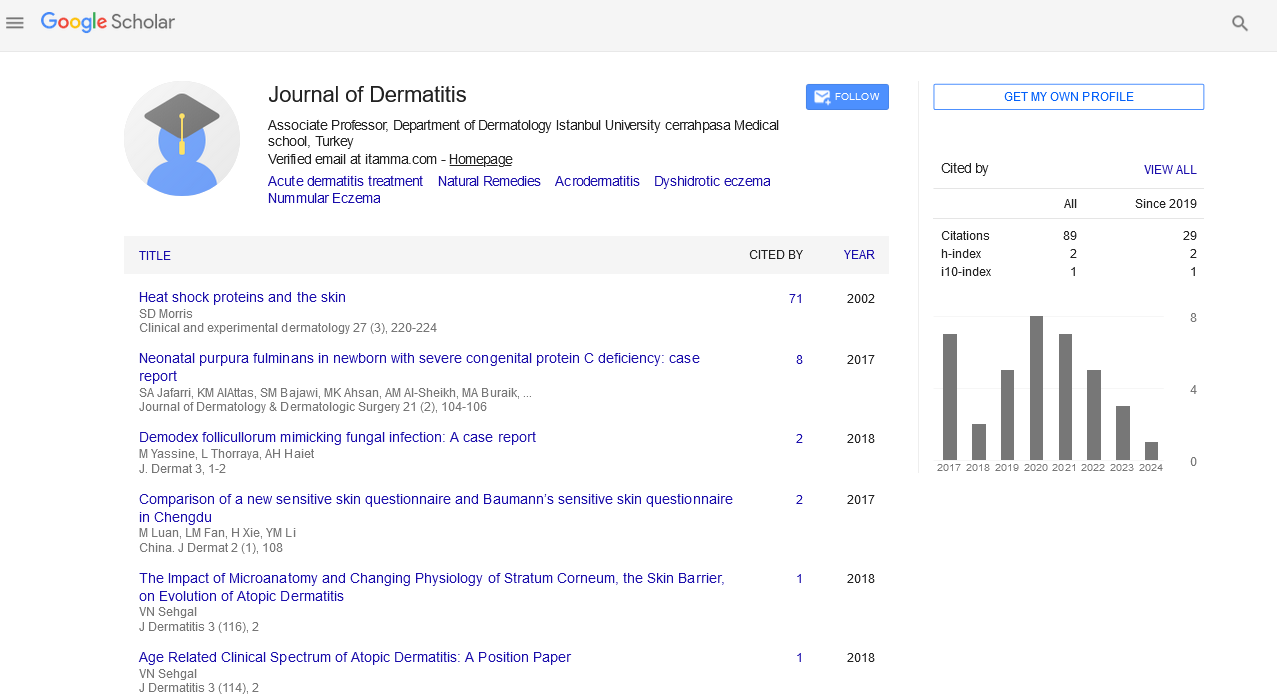Indexed In
- RefSeek
- Hamdard University
- EBSCO A-Z
- Euro Pub
- Google Scholar
Useful Links
Share This Page
Journal Flyer

Open Access Journals
- Agri and Aquaculture
- Biochemistry
- Bioinformatics & Systems Biology
- Business & Management
- Chemistry
- Clinical Sciences
- Engineering
- Food & Nutrition
- General Science
- Genetics & Molecular Biology
- Immunology & Microbiology
- Medical Sciences
- Neuroscience & Psychology
- Nursing & Health Care
- Pharmaceutical Sciences
Editorial - (2021) Volume 6, Issue 5
Editorial Note on Diaper Rash in Elderly
Penny Johnson*Received: 13-Sep-2021 Published: 04-Oct-2021, DOI: 10.35248/2684-1436.21.6.e136
Description
Diaper dermatitis is an irritation of the skin that happens near the area covered by a diaper, including the bottom, thighs, abdomen, or genital area, and it is usually called diaper rash. This is also referred to as incontinence-associated dermatitis, or skin irritation caused by urine. If the Diaper rash is left untreated infection can develop and can cause pain and discomfort. Signs of diaper dermatitis include small red or pink dots, blisters, inflamed skin, or redness. The skin may be itchy or painful. Diaper dermatitis is a variety of skin conditions and is one of the most common cutaneous disorders in infants. In general, the overall incidence due to Diaper dermatitis is between 7% and 35% with a peak at 9 to 12 months old infants and however, it may occur at any age and most of these diaper rash last about 24-48 hours and it can even be treated at home. Sometimes diaper rash can occur with some other skin problems like atopic dermatitis, psoriasis, and seborrhea and it may look like oozing or red blisters and crust may form on the area near the rash, redness of the skin with shiny patches. Diaper rash may clear up when diapers are changed frequently, non-prescription ointments are put in the skin and proper cleaning of the skin should be done. Treatment for a diaper rash is the same in both children as well as adults. Diaper rash is usually found near the diaper area like, buttocks, upper thighs, and genitalia, and the affected skin may be warm to the touch. The most common causes of diaper dermatitis are, not changing wet and dirty diapers frequently, rubbing of the skin by incontinence, skin reaction to detergents, perfumes, or diaper wipes. An infant with a diaper rash is more irritable and may cry while changing a diaper or when it is touched or cleaned and this infection is indicated with red bumps which are present near the skin folds or creases, pus, blisters, or swollen are the signs of diaper rash infection. There are some main causes of diaper dermatitis, such as:
Contact with feces or urine
Prolonged exposure to urine can irritate the skin. Contact with digestive enzymes found in feces may increase the risk of diaper rash. However, it may worsen the skin that has already irritated or inflamed.
Rubbing and Friction
Tight-fitting diaper against the skin leads to diaper rash and this damage to the skin can be made worsen if the skin is wet and even skin-to-skin contact with skin folds in the area of the diaper can leads to diaper rash.
Pre-existing skin conditions
Children with pre-existing skin conditions like eczema and dermatitis are more prone to develop a diaper rash.
Contact with irritating chemicals
If children’s bottom is very delicate, chemicals like detergents, soaps, fabric softeners, baby lotions, and baby wipes lead to irritation to the skin.
Infection
A dark, moist and damp environment which is created by a diaper leads to bleeding ground for yeast or bacterial infections on the skin and these types of infections are most commonly found in babies who have diaper rash. Red bumps, pus, blisters in the creases of the skin, outside the main redness, or severely swollen areas are the signs of infection.
Allergy to diaper elastic chemicals
A linear red rash near the belly and in the skin creases leads to an allergic reaction to chemicals in disposable diaper elastic. This can occur when you change to different brands of diapers.
Citation: Johnson P (2021) Editorial Note on Diaper Rash in Elderly. J Dermatitis. 6:e136.
Copyright: © 2021 Johnson P. This is an open-access article distributed under the terms of the Creative Commons Attribution License, which permits unrestricted use, distribution, and reproduction in any medium, provided the original author and source are credited.

